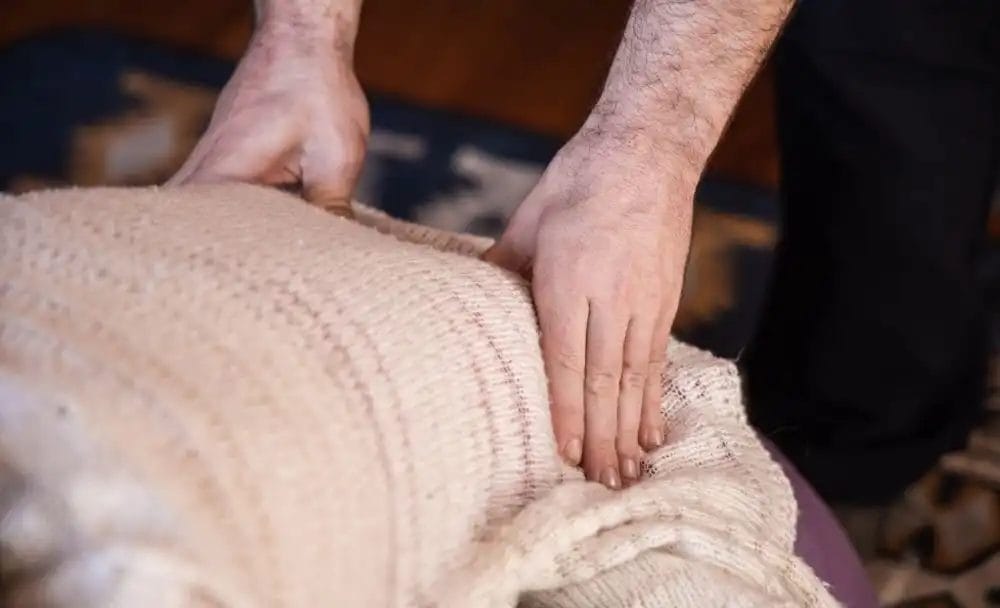This article is reviewed by Dr. Shankar Rao

Sacroiliitis is a condition characterized by inflammation in the sacroiliac joints, which are located in the lower back where the spine connects to the pelvis. This inflammatory disorder can cause significant discomfort and impact a person’s quality of life. In this comprehensive article, we will delve into the causes, symptoms, diagnosis, and treatment options for sacroiliitis from an Ayurvedic perspective.
Causes of Sacroiliitis
Sacroiliitis can arise from various factors, including [1]:
- Inflammatory Disorders
Inflammatory conditions such as ankylosing spondylitis, psoriatic arthritis, reactive arthritis, and inflammatory bowel disease (IBD) can contribute to the development of sacroiliitis. These conditions involve an abnormal immune response that triggers inflammation in the sacroiliac joints.
- Infection
Sacroiliitis can also be caused by an infection, such as a bacterial or viral infection. Infections that affect the urinary tract, gastrointestinal system, or other parts of the body can spread to the sacroiliac joints, leading to inflammation.
- Trauma or Injury
Trauma or injury to the sacroiliac joints, such as a fall, motor vehicle accident, or sports-related injury, can damage the joint structures and result in sacroiliitis.
- Pregnancy and Childbirth
The hormonal changes and increased stress on the pelvis during pregnancy can contribute to sacroiliitis. Additionally, the process of childbirth can put a strain on the sacroiliac joints, leading to inflammation.
- Mechanical Stress
Prolonged standing, walking, or engaging in activities that place repetitive stress on the sacroiliac joints can contribute to the development of sacroiliitis. This includes occupations or hobbies that involve heavy lifting, repetitive bending, or twisting motions.
Symptoms of Sacroiliitis
The symptoms of sacroiliitis can vary from person to person, and the severity can range from mild to severe. Common symptoms include [2]:
- Lower Back Pain
Sacroiliitis typically presents as pain in the lower back, primarily on one side. The pain may be dull, achy, or sharp, and it can radiate to the buttocks, hips, groin, or thighs. The pain is often aggravated by prolonged standing or walking and improves with rest.
- Hip and Buttock Pain
In addition, to lower back pain, sacroiliitis can cause pain and discomfort in the hips and buttocks. The pain may be localized or radiated down the leg, mimicking sciatica.
- Stiffness and Limited Range of Motion
Sacroiliitis can result in stiffness in the lower back, hips, and pelvis. This stiffness can make it difficult to perform everyday activities and may be more pronounced after periods of inactivity, such as waking up in the morning or sitting for an extended period.
- Pain with Movement
Activities that involve the sacroiliac joints, such as standing up from a seated position, climbing stairs, or running, can exacerbate pain and discomfort. Certain movements, such as bending forward or twisting the torso, may also be painful.
- Inflammation and Swelling
In some cases, sacroiliitis can cause inflammation and swelling around the sacroiliac joints. This can lead to localized tenderness and increased warmth in the affected area.
Diagnosis of Sacroiliitis
To diagnose sacroiliitis, healthcare professionals may employ various methods, including [3]:
- Medical History and Examination
The doctor collects your medical history and performs a physical examination to assess pain, range of motion, and signs of inflammation.
- Imaging Tests
X-rays, MRIs, or CT scans provide detailed images of the sacroiliac joints to evaluate joint damage, inflammation, or structural abnormalities.
- Blood Tests
ESR or CRP tests assess inflammation in the body, while specific blood tests may detect underlying autoimmune conditions associated with sacroiliitis.
- Diagnostic Injections
In some cases, diagnostic injections confirm the diagnosis by injecting an anaesthetic and corticosteroid into the sacroiliac joint to determine if the pain is alleviated.
Treatment of Sacroiliitis

The treatment approach for sacroiliitis focuses on relieving pain, reducing inflammation, improving joint function, and addressing the underlying causes. Ayurveda offers a holistic approach that encompasses lifestyle modifications, herbal remedies, and therapeutic interventions. Treatment options for sacroiliitis may include:
- Panchakarma Therapy
Ayurvedic detoxification and rejuvenation therapies, such as Abhyanga, Swedana, and Basti, help eliminate toxins, balance doshas, and restore the body’s equilibrium in sacroiliitis.
- Diet and Lifestyle Modifications
An anti-inflammatory diet rich in fruits, vegetables, whole grains, and healthy fats supports healing. Avoiding processed foods, refined sugars, and excessive caffeine is recommended. Many patients also benefit from gluten free diets [4]. Regular exercise, stress management, and maintaining good posture are crucial for managing sacroiliitis [5].
- Physical Therapy
Physical therapy improves pain, and mobility, and strengthens muscles around the sacroiliac joints. Customized programs include stretching, strengthening, and stabilization exercises [5].
- Pain Management
In severe cases, corticosteroid injections, NSAIDs, or prescribed medications may be used to manage pain and inflammation in sacroiliitis [1].
- Ayurvedic Medicines
Described as a type of Amavata in classical texts, Ayurvedic literature recommends some effective medications. These include options such as Dasamula niruha vasti, Brihatvata chintamaniras, Trayodasanga guggulu and Amavatariras, among others. Research shows that these herbal formulations can help curb disease progression, especially when used in combination with therapies like Shamana [6].
Conclusion
Sacroiliitis is a condition characterized by inflammation in the sacroiliac joints, causing pain, stiffness, and discomfort. Understanding the causes, recognizing the symptoms, and obtaining an accurate diagnosis is essential for effective treatment. Ayurveda offers a holistic approach to managing sacroiliitis, focusing on reducing inflammation, alleviating pain, and promoting joint healing. By incorporating Ayurvedic principles, lifestyle modifications, and herbal remedies, individuals with sacroiliitis can find relief and improve their overall well-being.
Frequently Asked Questions (FAQs)
What is bilateral sacroiliitis?
Bilateral sacroiliitis refers to the inflammation and pain occurring in both sacroiliac joints simultaneously. It can be caused by conditions like ankylosing spondylitis, psoriatic arthritis, or other inflammatory disorders.
Can sacroiliitis be seen on radiology imaging?
Radiology imaging, such as X-rays, MRIs, or CT scans, can help visualize the sacroiliac joints and identify signs of inflammation, damage, or structural abnormalities.
How long does it take to recover from sacroiliitis?
The recovery time for sacroiliitis varies depending on the individual, the severity of the condition, and the chosen treatment approach. With proper treatment and lifestyle modifications, most individuals experience improvement within a few weeks to a few months.
Can sacroiliitis be cured completely?
While sacroiliitis may not be curable in all cases, it can be effectively managed with appropriate treatment and lifestyle adjustments. With early diagnosis and comprehensive Ayurvedic management, individuals can experience reduced pain, improved joint function, and enhanced quality of life.
Disclaimer: The information provided here is for general information and not meant to substitute any medical advice. Please consult your doctor for appropriate medical consultation.
References:
- https://www.ncbi.nlm.nih.gov/books/NBK448141/
- https://www.ncbi.nlm.nih.gov/pmc/articles/PMC7532300/
- https://www.ncbi.nlm.nih.gov/pmc/articles/PMC9812593/
- https://www.ncbi.nlm.nih.gov/pmc/articles/PMC3085976/
- https://medlineplus.gov/ency/patientinstructions/000610.htm
- https://www.omicsonline.org/open-access/ayurvedic-management-of-spondyloartropathy-with-sacrolitis-2167-1206.1000119.php?aid=11902
















